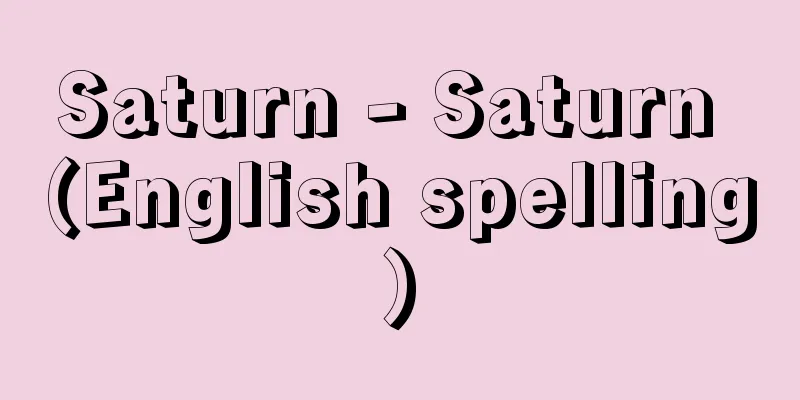Saturn - Saturn (English spelling)

|
A planet in the solar system. Of the eight planets, Saturn is the sixth farthest from the sun and revolves outside Jupiter. In Europe, Saturn was given the name Saturn, the father of Jupiter, the chief god of Roman mythology, and in China it was called Zhenxing. Its mean distance from the Sun is 9.5549 astronomical units (1,429,400,000 km), its orbital period is 29.458 years, its orbital eccentricity is 0.0556, and its inclination to the ecliptic plane is 2.488 degrees. Saturn's equatorial radius is 60,000 km, which is 9.4 times that of Earth, its volume is 745 times that of Earth, but its mass is only 95.16 times that of Earth, its average density is 0.70, and its equatorial gravity is 0.95 times that of Earth. Saturn is the second largest planet in the solar system after Jupiter, and is a so-called Jovian planet, but because it is far from Earth and has a fairly long orbital period, its movement on the celestial sphere is slow, and it is not as conspicuous as Mars or Jupiter. Its maximum brightness is -0.5 magnitude, but the famous tilt of its rings causes its brightness to change by about one magnitude at the time of opposition. Saturn's equatorial plane is tilted 26.7 degrees to the plane of its orbit, and its rings are also exactly aligned with the equatorial plane. The surface has faint stripes along the equator, but sharp spots are rarely seen. The rotation period is not easy to determine, but is thought to be 10 hours 14 minutes (near the equator) or 10 hours 38 minutes (at higher latitudes). However, the periodic variation of radio waves from Saturn gives a value of 10 hours 39.4 minutes. Spectroscopic observations have long known that methane and ammonia exist in Saturn's atmosphere, but the amount of ammonia is significantly less than that of Jupiter. This is thought to be because Saturn's surface is colder than Jupiter's and is frozen. Detailed information about Saturn was obtained by American space probes such as Pioneer 11 (1979), Voyager 1 (1980), and Voyager 2 (1982). The body of Saturn is very similar to that of Jupiter, but the stripes and vortexes on its surface are not as prominent as those on Jupiter. However, the Voyager images showed some very violent cloud flows and vortices. Saturn has less than one-third the mass of Jupiter, and its internal temperature and pressure are also considerably lower, and its metallic hydrogen core is thought to be small as well. This is also evidenced by the fact that the magnetic field measured by the probe was weaker than expected. Saturn's magnetosphere is also more regular in shape than Jupiter's, and its magnetic axis is aligned with its axis of rotation. Since the rings of Saturn were first identified by the Dutchman Huygens in 1656, they have been observed in greater detail with the development of telescopes, and it has been revealed that they are divided into three rings, A, B, and C, from the outside. Ring B is the brightest, followed by ring A, and ring C is also called the "crepe ring" because it is faint and translucent. In 1969, the existence of ring D, the innermost ring, was discovered. There is also a clear dark gap between rings A and B, called the Cassini Gap, and a gap called the Encke Gap can also be seen in ring A. The outer radius of ring A is 2.26 times the radius of Saturn, and the width from the outer side of ring A to the inner side of ring C is a total of 63,000 km. These rings gradually change their inclination during one revolution of Saturn, and they reach their most inclined state and horizontal state twice each. When viewed horizontally, they appear as thin straight lines, but at one point they were completely invisible even with large telescopes, and so their thickness was thought to be extremely thin. It has also been confirmed theoretically and through spectroscopic observations that these rings are a group of fine particles orbiting Saturn. Planetary probes have investigated and clarified the structure of the rings in far greater detail. Pioneer 11 discovered the thin F ring outside the A ring, and Voyager 1 and 2 confirmed the thin G ring and the faint, wide E ring even further out. They also clarified that the A, B, and C rings are a collection of several thousand thin rings. The particles that make up these rings have been measured to be ice chunks ranging in size from a few centimeters to a few meters. Saturn's eight moons were known to exist through telescopic observations, including Titan (magnitude 8), which was discovered by Huygens in 1655. However, in 1980, eight more moons were identified through ground-based observations when the rings were horizontal, and through the Voyager spacecraft, which also observed several other moons that had not yet been identified. A lot of information was also obtained about the surface and properties of the moons. Titan (2,575 km radius), the second largest moon in the solar system after Jupiter's Ganymede, was known to have a methane atmosphere from ground observations. The Voyager probes revealed that its atmosphere is mainly composed of nitrogen, with a surface pressure of 1.6 atmospheres. However, the surface was covered in a brownish haze and could not be observed. The presence of many craters was confirmed on the surfaces of Saturn's other moons, Rhea, Dione, Tethys, and Enceladus, and in particular, a large crater equivalent to one-third the diameter of Mimas was seen. All of these moons of Saturn have low density and are thought to be made up mostly of ice. It has long been known that the distribution of ring particles is controlled by the gravitational forces of the moons, but many of the newly discovered moonlets have interesting dynamic movements. There are "shepherd moons," two moonlets on either side of a thin ring that control the ring particles, a pair of moons that orbit very closely and alternate between orbits when they get too close, and moons that share the same orbit as another moon, located about 60 degrees ahead or behind it, which corresponds to the so-called equilateral triangle solution of the three-body problem. [Sadao Murayama] [References] | | | | |It is the second largest planet in the solar system after Jupiter. The particles that make up the rings are ice chunks ranging from a few centimeters to a few meters in size. Photographed by the Saturn probe "Cassini" from about 3 million km above the planet © NASA / JPL-Caltech / Space Science Institute "> Saturn Saturn's first moon. Diameter 396 km. Mimas's largest crater, Herschel, can be seen on the right. Photographed by the Cassini spacecraft © NASA/JPL-Caltech/Space Science Institute "> Mimas Saturn's second moon. Its diameter is about 500 km. Its surface is covered with ice, and it is thought that there is a layer of liquid underneath. Photographed by the planetary probe "Voyager 2" © NASA/JPL "> Enceladus Saturn's third moon. Diameter: 1070 km. The upper left shows Odysseus, the largest crater on Tethys. Photographed by the Cassini spacecraft © NASA/JPL/Space Science Institute "> Tethys Saturn's fourth moon. Diameter: 1,120 km. The line at the back is Saturn's ring. Photographed by the Cassini spacecraft © NASA/JPL-Caltech/Space Science Institute "> Dione Saturn's fifth moon. Diameter 1,528 km. Photographed by the Cassini spacecraft © NASA/JPL/Space Science Institute "> rare The sixth moon of Saturn. It is the largest of Saturn's moons, with a diameter of 5,150 km. It is covered in haze due to its thick atmosphere, which is mainly composed of nitrogen. Photographed by the Cassini spacecraft © NASA / JPL-Caltech / Space Science Institute "> Titanium Saturn's seventh moon. It is an irregular ellipsoid with a major axis of about 360 km, and its surface is covered with numerous deep craters. False-color image taken by the Cassini spacecraft © NASA/JPL/Space Science Institute "> Hyperion Saturn's eighth moon. Also called Iapetus or Iapetus. Diameter: 1,470 km. Photographed by the Cassini spacecraft © NASA/JPL/Space Science Institute "> Iapetus Source: Shogakukan Encyclopedia Nipponica About Encyclopedia Nipponica Information | Legend |
|
太陽系の惑星。8惑星のうち、太陽から第6番目の距離にあり、木星の外側を公転している。土星は、ヨーロッパではローマ神話の主神ユピテル(ジュピターJupiter=木星の英語名)の父にあたるサトゥルヌス(サターン)の名が与えられており、中国では鎮星(ちんせい)とよんだ。 太陽からの平均距離は9.5549天文単位(14億2940万キロメートル)、公転周期29.458年、軌道の離心率は0.0556、黄道面に対する傾斜角は2.488度である。土星の赤道半径は6万キロメートルで地球の9.4倍、体積は地球の745倍であるが、質量は地球の95.16倍しかなく、平均密度は0.70、赤道重力は地球の0.95倍である。 土星は、太陽系では木星に次いで2番目に大きい惑星であり、いわゆる木星型惑星に属するが、地球からの距離も遠く、公転周期もかなり長いため天球上の動きも緩やかであり、火星や木星のようには目だたない。極大光度はマイナス0.5等であるが、有名な環(わ)の傾きによって衝(しょう)のころの明るさは約1等級も変化する。 土星の赤道面は軌道面に対して26.7度傾いており、その環も正しく赤道面に一致している。表面には赤道に沿って淡い縞(しま)模様が見られるが、鮮明な斑点(はんてん)が見られることはまれである。自転周期を求めるのは容易でないが、10時間14分(赤道付近)ないし10時間38分(高緯度地方)とされている。一方、土星からの電波の周期変化からは10時間39.4分という値が得られている。 大気中には古くから分光観測によってメタンとアンモニアが存在することが知られているが、アンモニアは木星に比べて著しく少ない。これは、土星の表層が木星より低温であり、氷結しているためと考えられる。 土星についての詳細な情報は、アメリカの惑星探査機パイオニア11号(1979)、ボイジャー1号(1980)、同2号(1982)などによって得られた。 土星の本体は木星とよく似ているが、表面の縞や渦流などは木星ほど目だたない。しかしボイジャーの写真ではかなり激しい雲の流れや渦などが見られた。土星は質量が木星の3分の1たらずであり、内部の温度、圧力などもかなり小さく、金属状水素の中心核なども小さいと考えられる。探査機が測定した磁場が予想より弱かったこともこれを物語っている。また土星の磁気圏は木星に比べて整った形をしており、磁気軸も自転軸に一致している。 土星の環は、1656年オランダのホイヘンスによって確認されて以来、望遠鏡の発達とともにしだいに詳しく観測され、外側からA環、B環、C環の三つに分かれていることが明らかにされ、B環がもっとも明るく、A環がこれに次ぎ、C環は淡く半透明に見えるところから「ちりめん環」などともよばれた。また1969年にはもっとも内側にD環の存在が知られた。またA環とB環の間には明瞭(めいりょう)な暗いすきまがあって、カッシーニの空隙(くうげき)とよばれ、またA環の中にもエンケの空隙とよばれるすきまが見える。A環の外側の半径は土星半径の2.26倍に達し、またA環の外側からC環の内側までの幅は計6万3000キロメートルもある。これらの環は土星の1公転中にしだいにその傾きを変え、もっとも傾いた状態と水平の状態が2回ずつおこる。水平に見えるころは細い直線状に見えるが、一時期は大望遠鏡でもまったく見えなくなるところから、その厚さはきわめて薄いものと考えられてきた。また、これらの環が土星を巡る細かい粒子の群であることは理論的に、また分光観測によっても確かめられていた。惑星探査機は環の構造を格段に詳査し、解明した。パイオニア11号はA環の外側に細いF環を発見し、ボイジャー1号・2号はさらに外側に細いG環と、淡く幅広いE環などを確認した。またA・B・C環などが数千本に及ぶ細い環の集まりであることを解明した。これらの環をつくる粒子もおおむね数センチメートルから数メートル程度の氷塊であることが測定された。 土星には、1655年にホイヘンスが発見したチタン(明るさは8等級)ほか8個の衛星の存在が望遠鏡観測で知られていた。ところが1980年に、環が水平になった際の地上観測とボイジャー探査機の観測により、さらに8個が確認された。ボイジャーはそのほかにも未確認の数個を観測している。 衛星の表面や性質についても多くの情報が得られた。太陽系内の衛星では木星のガニメデに次いで大きいチタン(半径2575キロメートル)については、地上観測でもメタンの大気の存在が知られていた。ボイジャー探査機は、その大気が窒素を主成分とし、表面気圧1.6気圧にも及ぶものであることを明らかにした。しかし表面は茶褐色の霞(かすみ)に覆われて観測はできなかった。土星の他の衛星であるレア、ディオネ、テチス、エンケラドゥスなどの表面には多くのクレーターの存在が確かめられ、なかでもミマスにはミマスの直径の3分の1にも相当する大クレーターが見られた。これら土星の衛星はいずれも密度が小さく、大部分は氷でできていると考えられる。 なお、環の粒子の分布が衛星の引力に支配されていることは以前から知られていたが、新しく発見された小衛星は、その運動が力学的に興味深いものが多い。2個の小衛星が細い環の両側にあって、環の粒子を制御している「羊飼(ひつじか)い衛星」や、ごく接近した軌道を回っていて互いに接近すると交互に軌道を乗り換える一対の衛星、他の衛星と同一軌道上でその前方あるいは後方約60度に位置して、三体問題のいわゆる正三角形解に相当するものもある。 [村山定男] [参照項目] | | | | |太陽系では木星に次いで2番目に大きい惑星。環を構成する粒子は、数センチメートルから数メートルの氷塊である。土星探査機「カッシーニ」により、上空約300万kmから撮影©NASA/JPL-Caltech/Space Science Institute"> 土星 土星の第1衛星。直径396km。右側にミマス最大のクレーター「ハーシェル」が見える。土星探査機「カッシーニ」により撮影©NASA/JPL-Caltech/Space Science Institute"> ミマス 土星の第2衛星。直径約500km。表面は氷に覆われ、その下には液体の層があると考えられている。惑星探査機「ボイジャー2号」により撮影©NASA/JPL"> エンケラドゥス 土星の第3衛星。直径約1070km。左上はテチス最大のクレーター「オデュッセウス」。土星探査機「カッシーニ」により撮影©NASA/JPL/Space Science Institute"> テチス 土星の第4衛星。直径約1120km。後方の線状部は土星の環。土星探査機「カッシーニ」により撮影©NASA/JPL-Caltech/Space Science Institute"> ディオネ 土星の第5衛星。直径1528km。土星探査機「カッシーニ」により撮影©NASA/JPL/Space Science Institute"> レア 土星の第6衛星。土星の衛星としては最大で、直径5150km。おもに窒素からなる濃い大気により、霞に覆われている。土星探査機「カッシーニ」により撮影©NASA/JPL-Caltech/Space Science Institute"> チタン(タイタン) 土星の第7衛星。長径約360kmの不規則な楕円体で、表面には無数の深いクレーターが見られる。土星探査機「カッシーニ」による疑似カラー画像©NASA/JPL/Space Science Institute"> ヒペリオン 土星の第8衛星。イアペトゥス、イアペタスなどともいう。直径約1470km。土星探査機「カッシーニ」により撮影©NASA/JPL/Space Science Institute"> イアペトス 出典 小学館 日本大百科全書(ニッポニカ)日本大百科全書(ニッポニカ)について 情報 | 凡例 |
>>: Metropolitan system - Tosei
Recommend
Capolari, B.
... refers to a school of painting in the Umbria ...
Voroshilov, Kliment Efremovich
Born: February 4, 1881, Ekaterinoslav [Died] Decem...
Counterattack - Counterattack
It is one of the three major techniques in Judo, ...
minimum wage
…Most researchers usually distinguish between the...
Kreidolf, E. (English spelling) KreidolfE
...In East Germany, there was Werner Klemke, who ...
Synthetic natural gas (English spelling)
Abbreviated as SNG. Also called substitute natural...
Maggot - Maggot
A common name for the larvae of mainly flies in t...
Pennales
... Biddulphia , Chaetoceros , Triceratium , etc....
Takanori Yoshioka
A famous runner known as the "Super Express ...
Cork tissue
… In Japan, all of the amount used is imported fr...
Flowering - Kaika
This refers to the phenomenon in which flowers, t...
Kornfeld, P.
...E. Toller's autobiographical revolutionary...
Dryades
...She is said to be the mother of the Charites, ...
Naganao Asano
Year of death: July 24, 1672 (September 15, 1672) ...
Abelia uniflora (English spelling) Abelia uniflora
…[Makoto Fukuoka] [Makoto Wakisaka]. … *Some of t...









